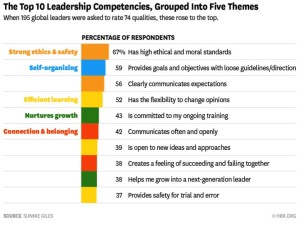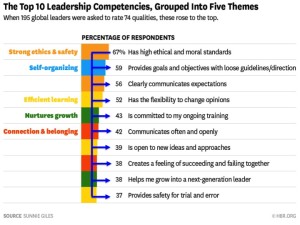195 leaders in 15 countries over 30 global organizations were asked to choose the 15 most important leadership competencies from a list of 74. Their survey results were reported and charted in the Harvard Business Review (March 15, 2016).
https://hbr.org/2016/03/the-most-important-leadership-competencies-according-to-leaders-around-the-world?referral=00563&cm_mmc=email-_-newsletter-_-daily_alert-_-alert_date&utm_source=newsletter_daily_alert&utm_medium=email&utm_campaign=alert_date
Today consultants and thought leaders race to find the holy grail of leadership. Research studies, such as the one above, inform us of amazing new insights into the mysteries of leadership but are leadership all that mysterious? Is there really some magic bullet that, once discovered, will open turn mere mortals into towering giants of leadership? The answer is a resounding NO. We know all there is to know about leadership and what it takes to be a great leader. The issue is not in gaining new data that titillates the mind but the key is to practice and apply what we know to be true from the heart.
Beyond the groupings of the HBR researcher (seen in the graph above), what does this list of leadership competencies tell us about leadership? There are multiple ways to view these survey results. An extremely valuable inquiry is to ask “what are the common areas of leadership that repeat in every study of effective leaders? These are the core skills that we need to focus on and strengthen. Consider the modification to the HBR graph below showing a grouping of competencies into three key leadership skills.
Leaders perform three essential tasks. They may be called different things by different authors but the tasks are the same and they show up in just about every leadership study. How the task is performed will vary depending on the leader’s style; the situation; and the people involved; but the tasks remain universal for all leaders.
Direction
First, leaders point direction. A leader moves to an end purpose and people who follow move with him or her. Without movement and change there is no need for leadership for that is what leaders create. Leaders point direction and to gain followers that direction must appeal to others (thus it must be morally and ethically acceptable to them). This is becoming more of an issue in our country as two very different value systems emerge and collide. What is morally and ethically acceptable is now defined in the eyes of the beholder and less a universally agreed upon standard. As a result, we observe students who are not willing to listen to others who espouse ethical standards or beliefs different from their own. We watch CEOs resign because they personally support causes, for religious or personal reasons, that are at odds with the consensus of their followers and who, therefore demand the leader step down. This dichotomy of values will become more and more of an issue in the future. As society and followers fracture on what is ethically and morally acceptable, fewer and fewer leaders will have universal appeal. Why is this important? Because there are many who would make outstanding leaders who will never lead because people will not follow them. These people may become visionaries or prophets but not leaders because leaders cannot exist without followers. The important issue is that setting direction, along with its related ethical and moral underpinnings is essential to leadership.
Question To Ponder
A key question for aspiring leaders is “does the leader shape the values and beliefs of the group or does the group shape the values and beliefs of the person so he or she is acceptable as a leader to them?” This is a moral dilemma a leader faces: does the leader say what the group wants to hear in order to curry favor and into a leadership position or does the leader say what he or she believes to see if anyone follows?”
Growth
Not only do leaders lead the way, they also grow things. In fact they grow three things: themselves, their people and the organization. These leadership activities are seen in the chart above.
Note growth begins with an item mentioned in the direction “bucket”: the leader provides goals and objectives with loose guidelines and direction. This is the foundation out of which growth occurs. The leader seldom decrees the method, the “how”. The leader allows people to grow through the struggle with how to achieve something. This is one of the problems with leadership today – all growth and development is structured and accomplished through programs – leadership development program, project management training program, etc. and ad infinitum. What ever happened to growth which allows room for the follower to struggle, to experiment, to learn by trial and error and ultimately to grow by spending long hours talking to a leader? The leader builds a culture of growth by providing goals and objectives and by clearly communicating expectations (what success looks like). Then he or she gets out of the way while followers figure out the “how”. This is the soil out of which follower engagement, commitment and ownership spring. Growth is as common to all leaders as is setting pointing direction.
People & Culture
Finally as the leader grows people and teaches behaviors consistent with that direction and values, he or she builds a culture: this is the way we behave. Culture is about people and their behavior and the leader cares about how followers act. It is not specific techniques that a leader teaches or even decisions he or she makes that makes a difference over the long run; instead, it is the impact the leader has on the life of the follower. This is accomplished by building a culture that demonstrates how to practice consistently what the leader and followers honor, value and believe in. This is where family begins and family means relationships. The final common trait of the leader is that or she makes an impact in people over time that allows the values taught to be lived out through others.
It’s Not A Mystery
Leadership is not rocket science. It is three simple tasks that are unbelievably difficult to live out consistently across multiple situations and with multiple unique followers. As Sunni Giles writes in the HBR article, “While some (of the competencies) may not surprise you, they’re all difficult to master, in part because improving them requires acting against our nature.” I agree these simple tasks are difficult to master but I do not think it is because they are against one’s nature. If they are, perhaps that person should never have been in leadership in the first place. What is hard is consistency when one is tired, exhausted and even discouraged because progress is not as quick as one would like. But consistency comes more easily when one practices what he or she believes to be true. That is the foundation of authenticity that naturally occurs when the leader’s high ethical and moral values are lived out through all the other leadership activities.
And after all, isn’t authenticity what followers are really seeking?
Copyright 9 By 9 Solutions 2016 All Rights Reserved



Doug, thanks for the article.
“Leadership is not rocket science.”
But many people seem to think if we can cram more knowledge into the heads of managers, then they’ll become leaders. Effective leadership requires more than knowledge.
“It is three simple tasks that are unbelievably difficult to live out consistently across multiple situations and with multiple unique followers.”
I agree, I suspect that we all have one or more leadership traits but that is not enough to make us leaders. Leadership is a lifestyle that few of us choose and even fewer of us can live. Leaders must:
– Give their word.
— Keep their word.
— Live their words.
— No excuses.
“… While some (of the competencies) may not surprise you, they’re all difficult to master, in part because improving them requires acting against our nature.””
That is true. If that is not true, then why is it so hard to educate/mentor/train good managers to become good leaders?
“I agree these simple tasks are difficult to master but I do not think it is because they are against one’s nature.”
Once we know how to discern the attributes of a successful leader finding them is not difficult.
“If they are, perhaps that person should never have been in leadership in the first place.”
I agree, but why do so many leaders fail at leading?
Why do some leaders act as if they are not leaders?
“What is hard is consistency when one is tired, exhausted and even discouraged because progress is not as quick as one would like.”
The discouraged leader is in the wrong job.
“But consistency comes more easily when one practices what he or she believes to be true.”
I’m afraid that also lets poor leaders to continue to be poor leaders because what they believe is true is not true.
“That is the foundation of authenticity that naturally occurs when the leader’s high ethical and moral values are lived out through all the other leadership activities.”
Where and when do I get high ethical and moral values? Answer, long before college.
High ethical standards and moral values are not acquired on the job or on college campuses, therefore they must be hired.